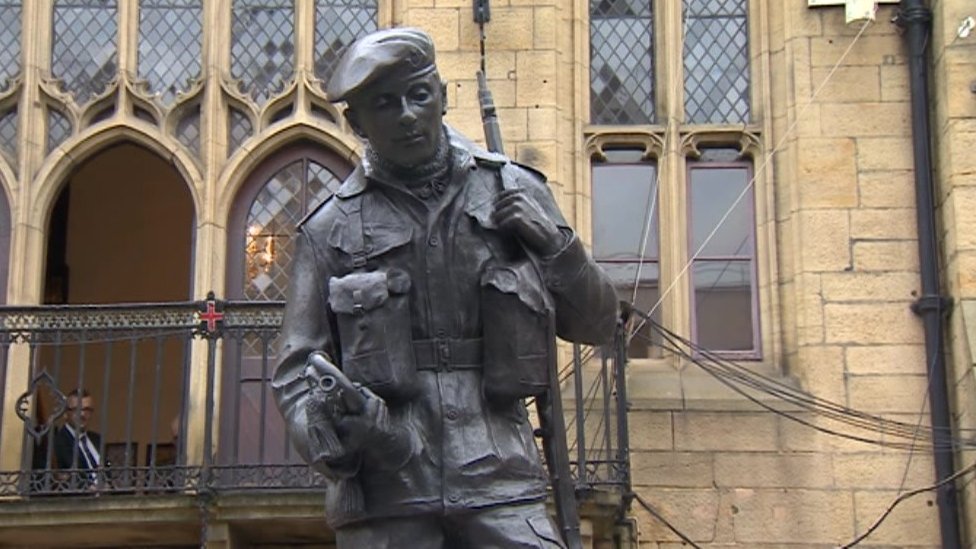The Durham Light Infantry (DLI) Memorial stands as a solemn and powerful tribute to one of Britain’s most distinguished regiments, located in the historic heart of Durham City. Positioned in the Market Place, the memorial pays lasting homage to the soldiers of the Durham Light Infantry who served their country across generations and global conflicts.
A Proud Regimental History
The Durham Light Infantry was formed in 1881 as part of the British Army’s restructuring of regiments and became synonymous with courage, discipline, and regional pride. However, the DLI’s history stretches back even further, tracing its lineage to earlier formations such as the 68th Regiment of Foot and the 106th Regiment of Foot.
The regiment drew heavily from the County of Durham, meaning that many soldiers were local men—mining sons, farmhands, clerks, and labourers who joined up in times of both peace and war. The DLI gained a fearsome reputation during the Boer War, World War I, World War II, and other 20th-century conflicts. Over the years, the regiment earned numerous battle honours, with its soldiers awarded decorations for exceptional bravery.
The Memorial’s Design and Meaning
Unveiled in 1928, the Durham Light Infantry Memorial is both simple and dignified in design. The centrepiece is a bronze figure of a DLI soldier in World War I uniform, standing at rest with his rifle. He gazes forward with a resolute expression—vigilant, calm, and grounded in duty. The figure was sculpted by C. L. Hartwell, a respected British sculptor known for his war memorials.
Beneath the statue is a stone plinth inscribed with the words:
“To the Glorious Memory of All Ranks of the Durham Light Infantry Who Gave Their Lives in the Service of Their Country.”
Additional plaques and inscriptions list campaigns and dates, each evoking sacrifices made in fields far from home: Flanders, France, North Africa, Italy, Burma and beyond.
Unlike more triumphalist war memorials, the DLI Memorial is reflective and humanising. It places the ordinary soldier—courageous but modest—at its centre, rather than generals or grand symbols of empire. This tone is appropriate for a regiment made up of working-class men from the coalfields and towns of County Durham.
A Place of Reflection and Ceremony
The DLI Memorial is not only a piece of sculpture; it remains a living site of remembrance. Every Remembrance Sunday, veterans, serving soldiers, civic leaders, and members of the public gather at the memorial to lay wreaths and hold silence for the fallen. The proximity to Durham Cathedral adds spiritual weight to the proceedings, and the setting—surrounded by trees and the quiet college buildings—encourages personal reflection.
The statue is also part of wider remembrance events tied to the DLI Chapel inside the cathedral, where the regiment’s colours are laid to rest and where additional memorials and artefacts are kept. Many families from the region have personal connections to the DLI, and visiting the memorial can be an emotional experience—linking private family histories with the collective memory of a community.
Legacy and the DLI Museum
Although the Durham Light Infantry Regiment was officially disbanded in 1968 and amalgamated into other units (eventually becoming part of The Rifles), its legacy remains deeply rooted in the region.
Until 2015, the Durham Light Infantry Museum in Durham housed an impressive collection of artefacts, uniforms, medals, photographs, and diaries. While the physical museum was closed, the collection is now held and curated by Durham County Council and the DLI Collection Gallery at the Palace Green Library, adjacent to Durham Cathedral, continues to share its history through exhibitions and outreach.
The DLI Memorial outside the cathedral therefore serves as a public face of this legacy—a fixed, enduring reminder of the cost of war and the enduring values of service and sacrifice.
Public Awareness and Educational Importance
In recent years, local efforts have focused on keeping the DLI’s story alive. Education programmes, school visits, and community events linked to the memorial and the broader collection aim to teach younger generations about the region’s role in global conflicts.
The statue is also a common stop on walking tours of Durham, providing an opportunity to speak about both the regimental history and the human cost of war. Whether viewed by locals, tourists, students, or descendants of soldiers, the memorial evokes a powerful and often personal response.
Conclusion: Memory Cast in Bronze
The Durham Light Infantry Memorial is more than just a statue—it is a gateway to remembrance, history, and identity. It speaks not just to military glory, but to loss, resilience, and the spirit of ordinary men called upon to do extraordinary things.
As long as it stands near the cathedral’s ancient walls, the figure of the DLI soldier will continue to represent the courage of those who served, the sorrow of those who mourned, and the pride of a county that remembers.

